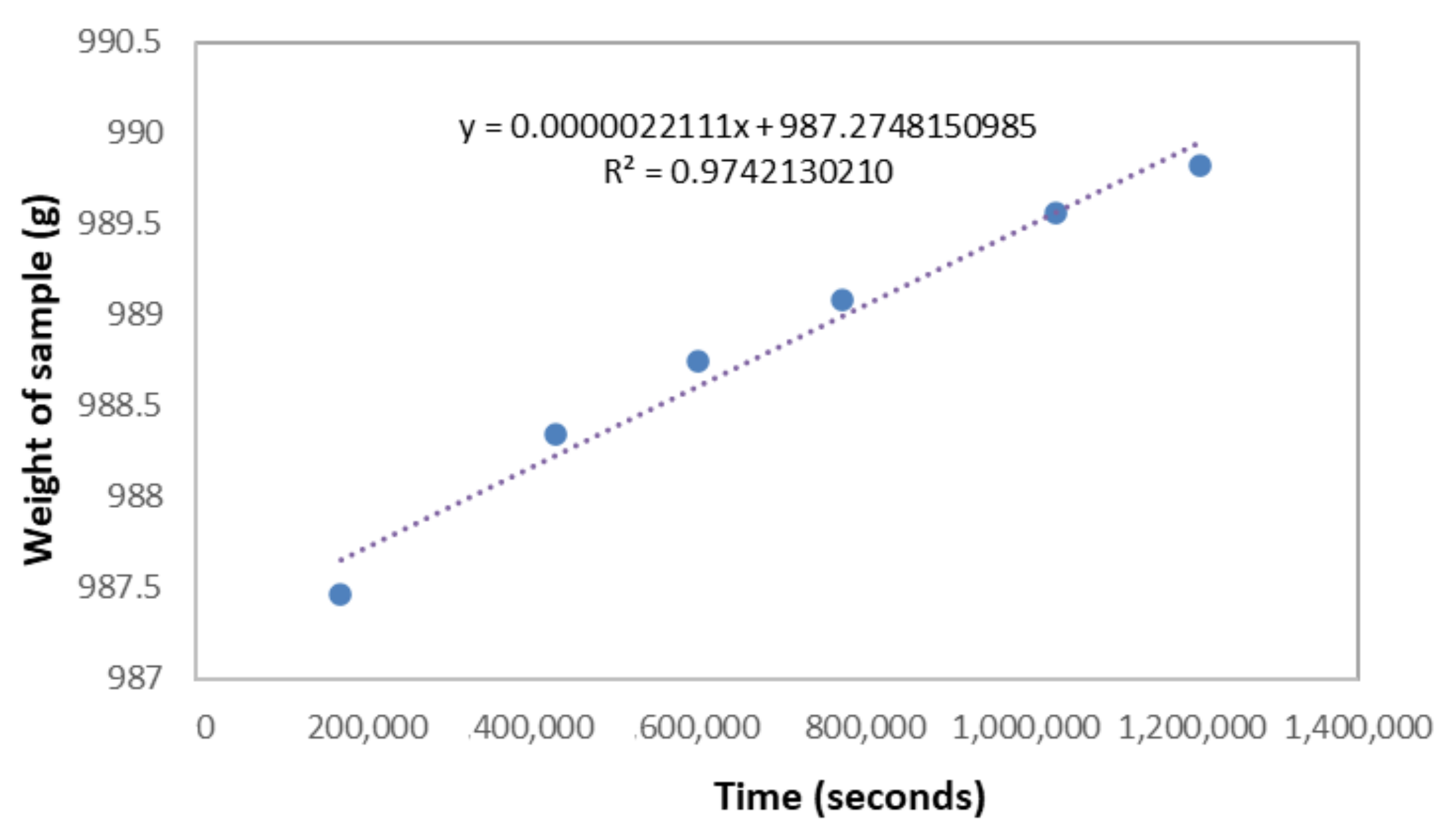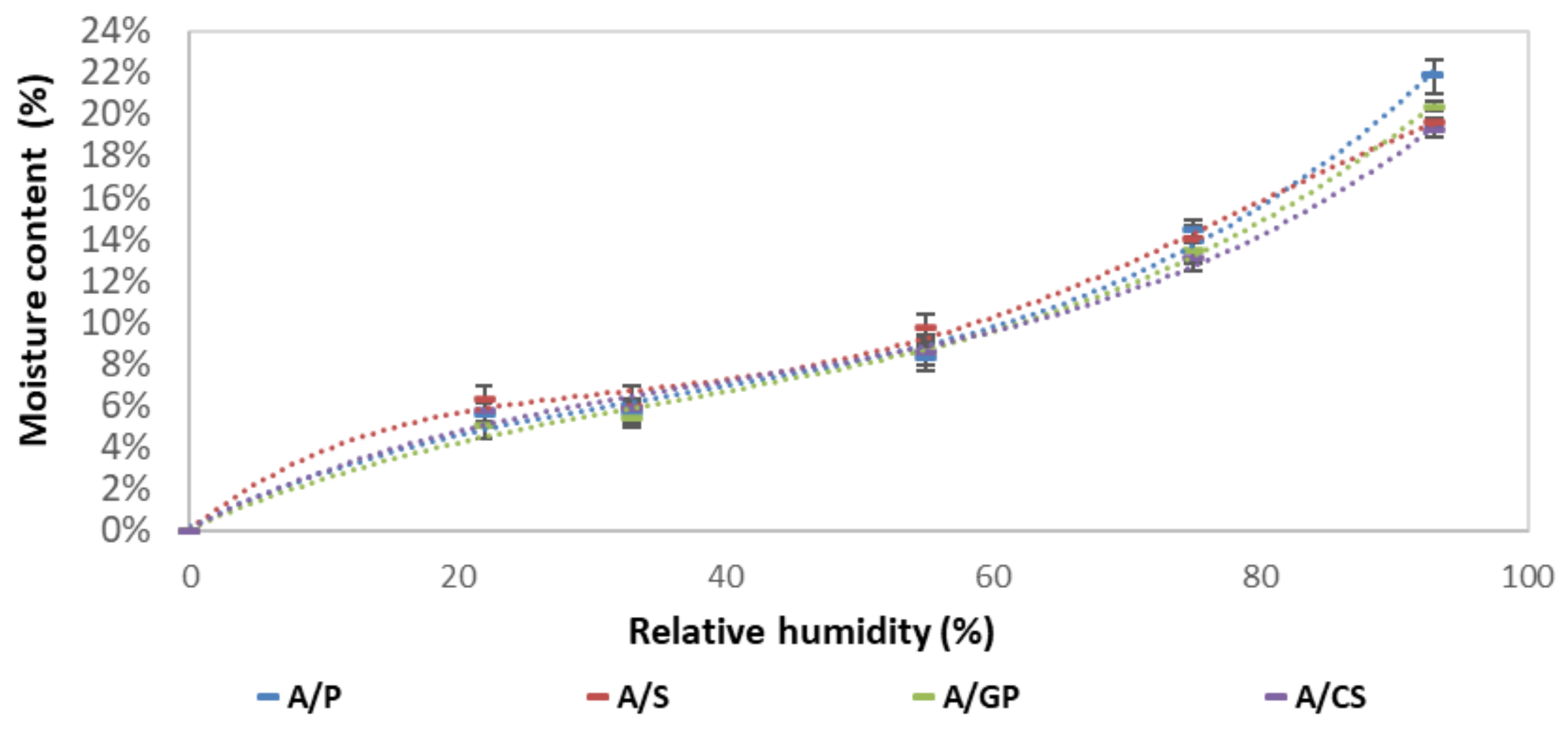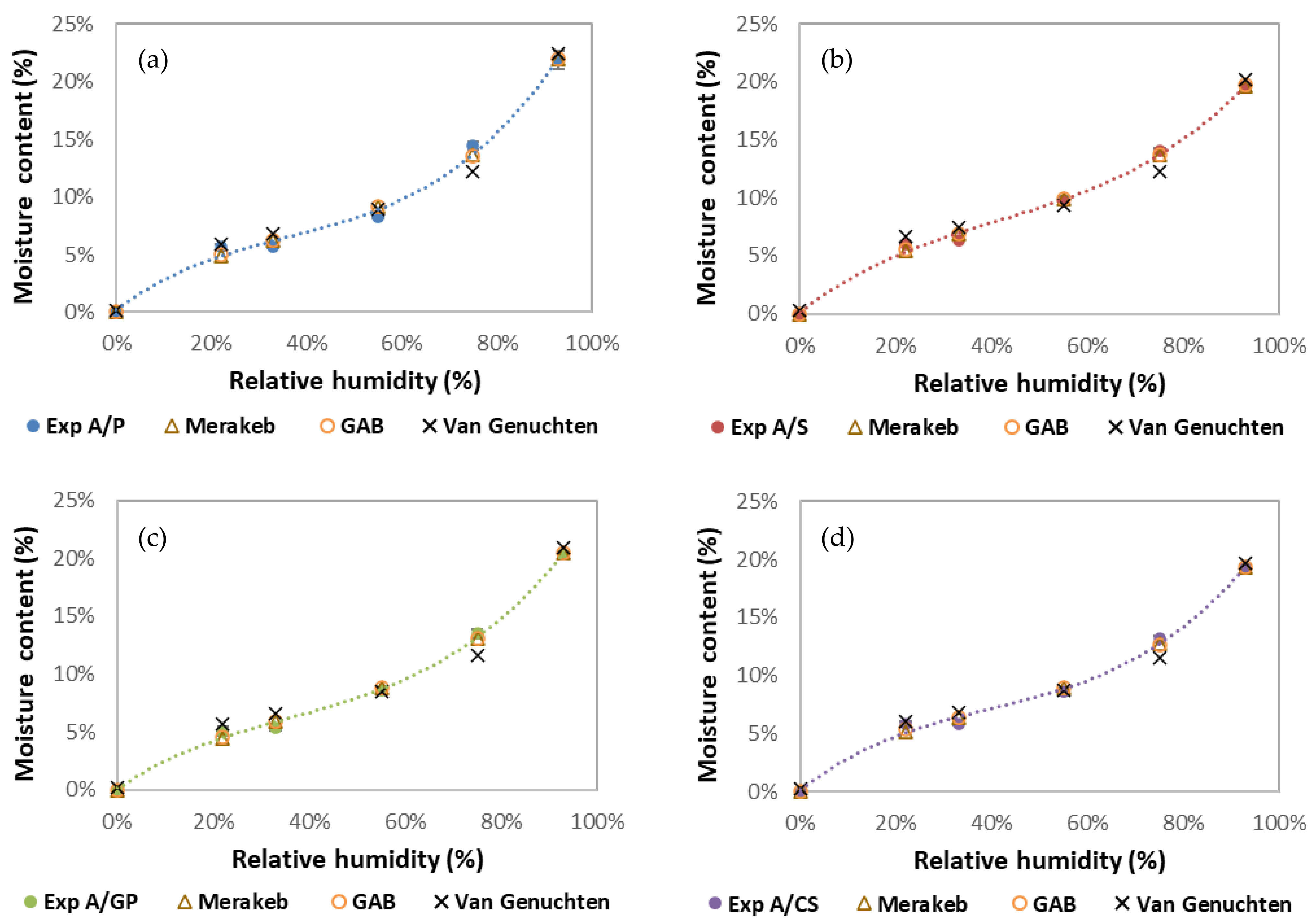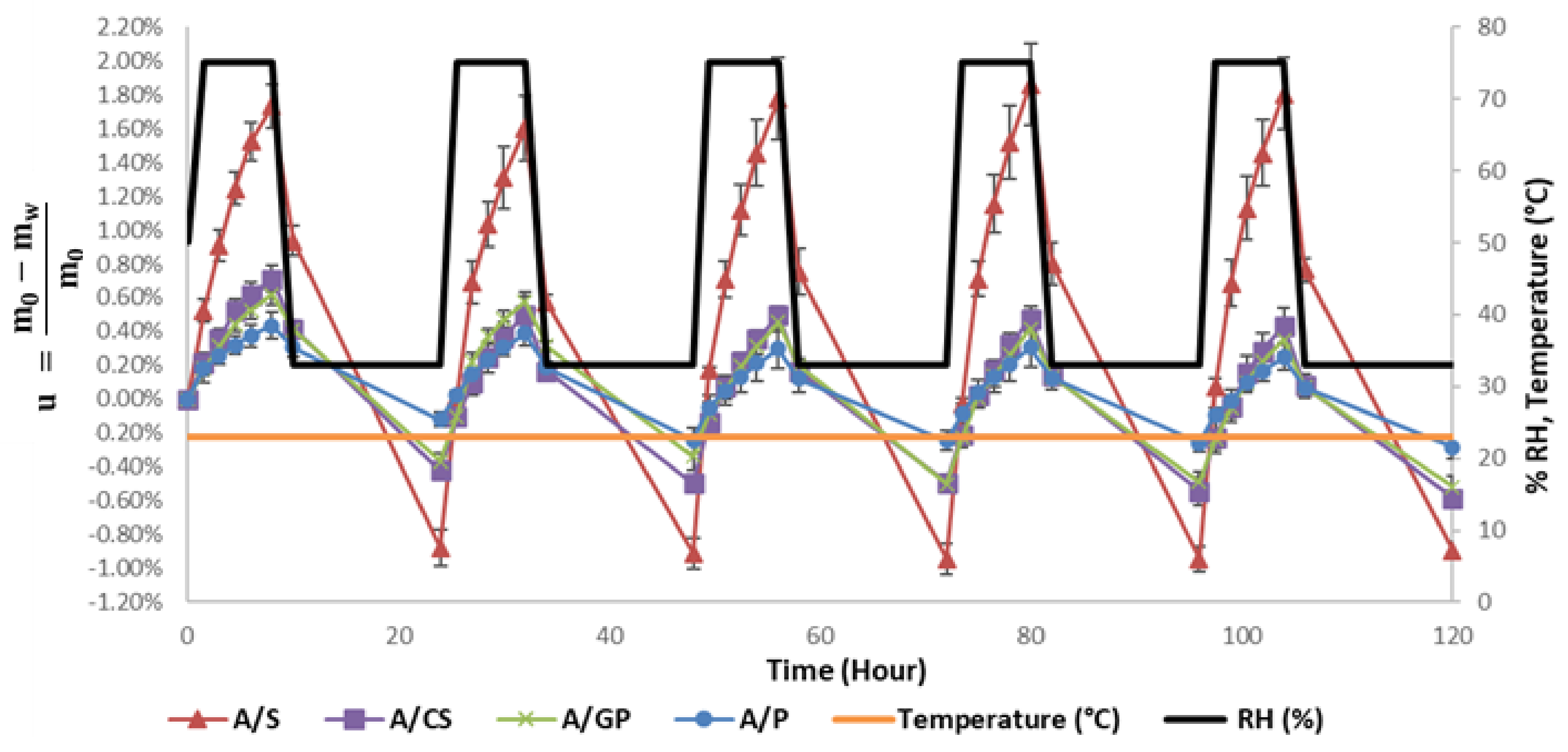Hygric Behavior of Viticulture By-Product Composites for Building Insulation
Abstract
:1. Introduction
2. Materials and Methods
2.1. Materials and Samples
2.2. Characterizations
2.2.1. Permeability
2.2.2. Sorption Isotherm
2.2.3. Moisture Buffer Value (MBV)
3. Results and Discussion
3.1. Permeability
3.2. Sorption Isotherm
3.3. Moisture Buffer Value (MBV)
4. Conclusions
Author Contributions
Funding
Institutional Review Board Statement
Informed Consent Statement
Data Availability Statement
Acknowledgments
Conflicts of Interest
Nomenclature
| Roman | |
| a | Merakeb model constant |
| A | Exposed area (m2) |
| A/CS | Starch/crushed stalk composite |
| A/P | Starch/grape skin composite |
| A/GP | Starch/grape pomace composite |
| A/S | Starch/stalk composite |
| b | Merakeb model constant |
| BP/S | Beet pulp/starch composite |
| CG | GAB parameters |
| d | Thickness (m) |
| E | Mean deviation (%) |
| G | Mass flow rate (kg·s−1) |
| RH | Relative humidity (%) |
| H/S | Hemp/starch composite |
| HRinf | Low relative humidity (%) |
| HRsup | High relative humidity (%) |
| K | GAB parameters |
| m0 | Dry mass of the sample (g) |
| mi | Mass of the sample at a given relative humidity (g) |
| mw | Mass of the water absorbed by the sample (g) |
| MBV | Moisture buffer value (g·m−2·% RH−1) |
| R2 | Correlation coefficient |
| RMSE | Mean quadratic error |
| Sd | Equivalent air layer depth for water vapor diffusion (m) |
| u | Moisture content (%) |
| us | Saturation moisture content (%) |
| W | Moisture content (kg) |
| Wm | Saturation moisture content (kg) |
| Δm | Mass variation during the adsorption phase (g) |
| ΔPv | Water vapor pressure gradient (Pa) |
| Greek | |
| αT | van Genuchten parameters |
| δa | Water vapor permeability of the air (kg·m−1·s−1·Pa−1) |
| δv | Water vapor permeability (kg·m−1·s−1·Pa−1) |
| ηT | van Genuchten parameters |
| μ | Water vapor resistance factor |
| φ | Relative humidity (%) |
References
- International Energy Agency. Capturing the Multiple Benefits of Energy Efficiency. 2014. Available online: https://www.iea.org/reports/capturing-the-multiple-benefits-of-energy-efficiency (accessed on 19 November 2021).
- Ürge-Vorsatz, D.; Eyre, N.; Graham, P.; Harvey, D.; Hertwich, E.; Jiang, Y.; Kornevall, C.; Majumdar, M.; McMahon, J.E.; Mirasgedis, S.; et al. Energy End-Use: Buildings. In Global Energy Assessment: Toward a Sustainable Future; Global Energy Assessment Writing Team, Ed.; Cambridge University Press: Cambridge, UK, 2012; pp. 649–760. ISBN 9781107005198. [Google Scholar]
- Charlot-Valdieu, C.; Outrequin, P. La Transition Énergétique des Bâtiments Publics; Bâtiment Passif et Bepos, les Enjeux de la RE 2020 —Territorial; Librairie Gallimard: Paris, France, 2021. [Google Scholar]
- Asdrubali, F.; Baldassarri, C.; Fthenakis, V. Life cycle analysis in the construction sector: Guiding the optimization of conventional Italian buildings. Energy Build. 2013, 64, 73–89. [Google Scholar] [CrossRef]
- Lawrence, M.; Shea, A.; Walker, P.; De Wilde, P. Hygrothermal performance of bio-based insulation materials. Proc. Inst. Civ. Eng.—Constr. Mater. 2013, 166, 257–263. [Google Scholar] [CrossRef] [Green Version]
- Palumbo, M.; Lacasta, A.M.; Holcroft, N.; Shea, A.; Walker, P. Determination of hygrothermal parameters of experimental and commercial bio-based insulation materials. Constr. Build. Mater. 2016, 124, 269–275. [Google Scholar] [CrossRef] [Green Version]
- Fedorik, F.; Zach, J.; Lehto, M.; Kymäläinen, H.-R.; Kuisma, R.; Jallinoja, M.; Illikainen, K.; Alitalo, S. Hygrothermal properties of advanced bio-based insulation materials. Energy Build. 2021, 253, 111528. [Google Scholar] [CrossRef]
- Korjenic, A.; Petránek, V.; Zach, J.; Hroudová, J. Development and performance evaluation of natural thermal-insulation materials composed of renewable resources. Energy Build. 2011, 43, 2518–2523. [Google Scholar] [CrossRef]
- Liu, L.; Li, H.; Lazzaretto, A.; Manente, G.; Tong, C.; Liu, Q.; Li, N. The development history and prospects of biomass-based insulation materials for buildings. Renew. Sustain. Energy Rev. 2017, 69, 912–932. [Google Scholar] [CrossRef]
- Badouard, C.; Bogard, F.; Bliard, C.; Lachi, M.; Abbes, B.; Polidori, G. Development and characterization of viticulture by-products for building applications. Constr. Build. Mater. 2021, 302, 124142. [Google Scholar] [CrossRef]
- Hygrothermal Performance of Building Materials and Products—Determination of Water Vapour Transmission Properties—Cup Method; AFNOR: Paris, France, 2016.
- Hygrothermal Performance of Building Materials and Products—Determination of Hygroscopic Sorption Properties; AFNOR: Paris, France, 2013.
- Merakeb, S.; Dubois, F.; Petit, C. Modeling of the sorption hysteresis for wood. Wood Sci. Technol. 2009, 43, 575–589. [Google Scholar] [CrossRef]
- Anderson, R.B. Modifications of the Brunauer, Emmett and Teller Equation. J. Am. Chem. Soc. 1946, 68, 686–691. [Google Scholar] [CrossRef]
- Genuchten Van, M.T. A Closed-form Equation for Predicting the Hydraulic Conductivity of Unsaturated Soils. Soil Sci. Soc. Am. J. 1980, 44, 892–898. [Google Scholar] [CrossRef] [Green Version]
- Rode, C.; Peuhkuri, R.H.; Mortensen, L.H.; Hansen, K.K.; Time, B.; Gustavsen, A.; Ojanen, T.; Ahonen, J.; Svennberg, K.; Arfvidsson, J.; et al. Moisture Buffering of Building Materials; BYG Report No. R-127; Technical University of Denmark, Department of Civil Engineering: Kongens Lyngby, Denmark, 2005. [Google Scholar]
- Umurigirwa-Vasseur, B.S. Elaboration et Caractérisation d’un Agromatériau Chanvre-Amidon Pour le Bâtiment. Ph.D. Thesis, Université de Reims of Reims Champagne Ardennes, Reims, France, December 2014. [Google Scholar]
- Karaky, H.; Maalouf, C.; Bliard, C.; Moussa, T.; El Wakil, N.; Lachi, M.; Polidori, G. Hygrothermal and Acoustical Performance of Starch-Beet Pulp Composites for Building Thermal Insulation. Materials 2018, 11, 1622. [Google Scholar] [CrossRef] [PubMed] [Green Version]
- Park, G.S. Transport Principles—Solution, Diffusion and Permeation in Polymer Membranes. In Synthetic Membranes: Science, Engineering and Applications; Bungay, P.M., Lonsdale, H.K., de Pinho, M.N., Eds.; NATO ASI Series; Springer: Dordrecht, The Netherlands, 1986; pp. 57–107. ISBN 9789400947122. [Google Scholar]
- Célino, A.; Fréour, S.; Jacquemin, F.; Casari, P. The hygroscopic behavior of plant fibers: A review. Front. Chem. 2014, 1, 43. [Google Scholar] [CrossRef] [PubMed] [Green Version]
- Collet, F. Caractérisation Hydrique et Thermique de Matériaux de Génie Civil a Faibles Impacts Environnementaux. PhD. Thesis, INSA Rennes, Rennes, France, December 2004. [Google Scholar]
- Zhang, H. (Ed.) Heat-insulating materials and sound-absorbing materials. In Building Materials in Civil Engineering; Woodhead Publishing: Cambridge, UK, 2011; pp. 304–315. [Google Scholar]
- Monnet, D. Etude de l’Évolution Des Propriétés Mécaniques de Matériaux Amylacés Par Sélection et/ou Modifications Structurales Dirigées. Ph.D. Thesis, Université de Reims Champagne Ardennes, Reims, France, 2008. [Google Scholar]
- Maalouf, C.; Vasseur-Umurigirwa, B.S.; Viens, N.; Lachi, M.; Mai, T.H. Study of the Hygric Behaviour and Moisture Buffering Performance of a Hemp–Starch Composite Panel for Buildings. Bioresources 2015, 10, 336–347. [Google Scholar] [CrossRef]
- Rode, C.; Peuhkuri, R.; Svennberg, K.; Ojanen, T.; Mukhopadhyaya, P.; Kumaran, M.; Dean, S.W. Moisture Buffer Value of Building Materials. J. ASTM Int. 2007, 4, 4. [Google Scholar] [CrossRef] [Green Version]
- Brouard, Y. Caractérisation et Optimisation d’un Composite Biosourcé pour l’Habitat. Ph.D. Thesis, Université de Tours, Tours, France, May 2018. [Google Scholar]






| Composite | Abbreviations | ρbulk |
|---|---|---|
| (kg·m−3) | ||
| Starch/grape skin | A/P | 433 ± 78 |
| Starch/grape pomace | A/GP | 308 ± 32 |
| Starch/stalk | A/S | 227 ± 47 |
| Starch/crushed stalk | A/CS | 345 ± 35 |
| Composite | δv × 10−11 | µ | Sd |
|---|---|---|---|
| (kg·m−1·s−1·Pa−1) | (m) | ||
| A/P | 1.57 ± 0.16 | 12.83 ± 1.38 | 0.57 ± 0.06 |
| A/GP | 1.79 ± 0.12 | 11.22 ± 0.70 | 0.51 ± 0.02 |
| A/S | 1.40 ± 0.15 | 14.37 ± 1.59 | 0.66 ± 0.06 |
| A/CS | 1.65 ± 0.21 | 12.30 ± 1.69 | 0.58 ± 0.09 |
| Models | Parameters | A/P | A/S | A/GP | A/CS |
|---|---|---|---|---|---|
| Merakeb | us | 0.2771 | 0.2322 | 0.2519 | 0.2375 |
| a | 0.8408 | 0.7298 | 0.8516 | 0.7297 | |
| b | 1.4326 | 1.2214 | 1.3056 | 1.4581 | |
| E (%) | 7.7686 | 4.1947 | 5.3678 | 5.6578 | |
| R2 | 0.9961 | 0.9985 | 0.9983 | 0.9979 | |
| RMSE | 0.0062 | 0.0034 | 0.0037 | 0.0042 | |
| GAB | Wm | 0.0557 | 0.0664 | 0.0581 | 0.0539 |
| Cg | 13.0356 | 12.3401 | 9.0035 | 22.285 | |
| K | 0.8099 | 0.7267 | 0.7825 | 0.7809 | |
| E (%) | 7.5877 | 4.1004 | 5.4752 | 5.1060 | |
| R2 | 0.9960 | 0.9985 | 0.9983 | 0.9979 | |
| RMSE | 0.0063 | 0.0034 | 0.0038 | 0.0040 | |
| van Genuchten | Us | 0.0015 | 0.0027 | 0.0016 | 0.0021 |
| αT | 0.0000 | 0.0000 | 0.0000 | 0.0000 | |
| ηT | 1.4422 | 1.3722 | 1.4330 | 1.3947 | |
| E (%) | 9.4271 | 9.3195 | 9.7917 | 7.1207 | |
| R2 | 0.9887 | 0.9883 | 0.9893 | 0.9913 | |
| RMSE | 0.0106 | 0.0097 | 0.0097 | 0.0081 |
| Composite | MBV | Classification |
|---|---|---|
| (g·m−2·% RH−1) | ||
| A/P | 1.92 ± 0.45 | Good |
| A/GP | 2.57 ± 0.22 | Excellent |
| A/S | 6.31 ± 0.60 | Excellent |
| A/CS | 3.50 ± 0.20 | Excellent |
Publisher’s Note: MDPI stays neutral with regard to jurisdictional claims in published maps and institutional affiliations. |
© 2022 by the authors. Licensee MDPI, Basel, Switzerland. This article is an open access article distributed under the terms and conditions of the Creative Commons Attribution (CC BY) license (https://creativecommons.org/licenses/by/4.0/).
Share and Cite
Badouard, C.; Maalouf, C.; Bliard, C.; Polidori, G.; Bogard, F. Hygric Behavior of Viticulture By-Product Composites for Building Insulation. Materials 2022, 15, 815. https://doi.org/10.3390/ma15030815
Badouard C, Maalouf C, Bliard C, Polidori G, Bogard F. Hygric Behavior of Viticulture By-Product Composites for Building Insulation. Materials. 2022; 15(3):815. https://doi.org/10.3390/ma15030815
Chicago/Turabian StyleBadouard, Céline, Chadi Maalouf, Christophe Bliard, Guillaume Polidori, and Fabien Bogard. 2022. "Hygric Behavior of Viticulture By-Product Composites for Building Insulation" Materials 15, no. 3: 815. https://doi.org/10.3390/ma15030815
APA StyleBadouard, C., Maalouf, C., Bliard, C., Polidori, G., & Bogard, F. (2022). Hygric Behavior of Viticulture By-Product Composites for Building Insulation. Materials, 15(3), 815. https://doi.org/10.3390/ma15030815






